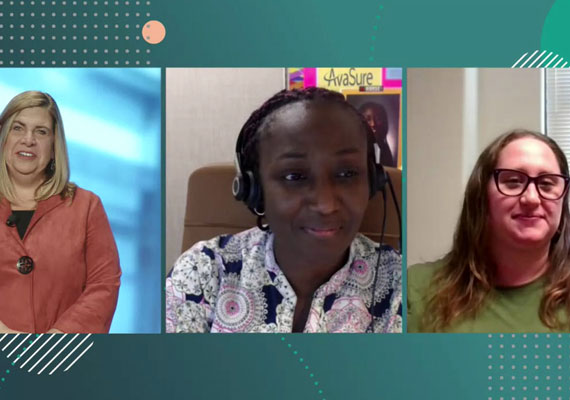Tips, Tricks, and Tales from Monitor Staff Superstars
No topics assigned.
December 5, 2022
Many conversations surrounding AvaSure TeleSitter® or TeleNurse® programs focus on the burden removed from the bedside care team & the benefits to patient.
Many conversations surrounding AvaSure TeleSitter® or TeleNurse® programs focus on the burden removed from the bedside care team & the benefits to patient.

Transforming the Industry: Avasure Virtual Symposium Recap
Many conversations surrounding AvaSure TeleSitter® or TeleNurse® programs focus on the burden removed from the bedside care team & the benefits to patient outcomes, but the forgotten superstar is often the care provider on the other side of the device. In this session, we had the opportunity to speak with two phenomenal monitor staff managers who lead effective teams that work tirelessly to keep patients & staff safe. As Juliet said, “it’s not just about the patient alone – it’s also about protecting staff while they work tirelessly to provide care.” Read on to learn more about their tips, best practices & experiences as monitor staff, program leaders & facilitators of great patient care.
Panelists:
Kearston Winder, Ascension Via Christi
Juliet Aninye, LVN, VA North Texas Health Care System
Q: What Was It Like Verbally Redirecting Patients For The First Time?
- Kearston was excited to be able to help the floor staff & help in managing the patient. She felt apart of the care team and during her first intervention, was trying to get a patient to keep their oxygen on. She felt great when the floor staff immediately recognized her work reaching out to say thank you & share their gratitude, she was watching their patient. This acknowledgment went a long way in her feeling valued in her role.
Q: Were You Skeptical When You First Heard About The Avasure Telesitter Program?
- Juliet had a strong interest coming from a long term care environment. The VA already had a program in place when she joined, but when she was trained by current monitor staff & rounding with the bedside staff, she got a new perspective on the work. She was excited by the challenge of getting the program on the right track to work in partnership with the bedside team & help to expand the program further.
Q: What Best Practices Are There For Developing Relationships With Patients & Does That Help With Redirecting Them?
- It’s all about communication. Acknowledgement that their need is heard goes a long way – let them know you’re going to get their nurse, come back on after making the call to say someone is coming and check in after that everything is okay. Providing verbal feedback goes a long way.
- Introductions can help to ensure they understand the why & view the camera as a helper. Build some rapport by having a conversation with them so you build confidence that this tool is to keep them safe, not some sort of “big brother.”
- When verballing queuing, make sure it comes across in the tone of, “how can I help you?”
- If possible, having a manager round in person to introduce the device and program and verbally prompting the introduction of the monitor staff can go a long way to build confidence – especially if the family is in the room. This usually opens a dialogue for questions and ends with a positive view of the monitor’s role.
- Best Practice: in a VA setting, patients are at high risk of having some form of PTSD. In these situations, when doing introductions walk them through what a verbal intervention & stat alarm will sound like. This can help ensure they aren’t startled, especially when sleeping, potentially causing a trigger.
Q: What Are Some Best Practices For Handoff?
- You need to ensure you consider both types of handoff – handoff from one monitor staff to another about a patient, but also handoff from one bedside nurse to another for the monitor staff. It all comes down to communication! A best practice from one panelist is a handoff report sheet where they document any key events, patient/nurse preferences or interventions during the 8 hour shift. That sheet is then passed to the next staff member & so on. This allows for a record for the particular patient that can be referenced at any time.
- When it comes to the bedside nurses, ensure you always check in at the beginning of a new nurses shift to see if there are changes to be aware of. Different nurses may have different preferences for what you watch for, communication, etc. so reset expectations with every shift.
- Monitor staff can provide valuable information to the bedside staff during report outs on things to watch for, the patient condition over the past days & if they’ve been “busy.”
- If you’re in a hub & spoke model, ensure there is a standard procedure across all facilities to ensure ease of compliance for your monitor team
- Constant, easy communication between the monitor staff & front-line staff is the key to a successful program – at all times, not just at shift change or handoff.
Q: Monitor Staff Sometimes Witness Upsetting Events They May Not Be Used To If They Didn’t Come From A Clinical Environment. How Do Leaders Support Staff During These Events?
- Staff without previous hospital experience may be overcome by events like a patient passing away and can be unsure how to move past such an event. Ensure they feel comfortable being able to reach out to their manager whenever such an event may occur. Listen to them openly and continuously follow up/check in on them over the coming days or weeks. It can be helpful to use the data & reporting available to show that they fulfilled their role to the best of their abilities and that there wasn’t anything they could do. Bedside staff are typically supportive in these situations as well, especially if an adverse event like a fall occurred, assuring the monitor staff that they followed all procedure correctly. This can help to alleviate guilt they may feel.
- If your facility has employee assistance program for clinical staff dealing with these situations, extend it to monitor staff so they can have a support network.
- Use any adverse event as a learning opportunity for the team to review what happened, what interventions occurred, and discuss if there were any further actions that could be taken in the future.
- Be supportive, understanding and transparent with your team – this goes a long way!
A great catch from Juliet: “We had just admitted a new patient to the AvaSure TeleSitter program and within a few minutes, the monitor staff could tell something didn’t look quite right. The monitor staff called the nurse right away and discovered the patient was unconscious. A rapid response was called and the patient was then transferred to the ICU. This could have been an adverse event without the camera, as it would’ve been a while for the patient to be checked on. The bedside staff called the monitor staff later that day to thank them for alerting staff in item to catch this.”
Monitor staff are key members of the care team who build relationships with the patients & provide essential care. Sometimes, these team members are monitoring patients for weeks, months or longer – so it’s important to realize the impact they are making. A best-in-class TeleSitter program has communication, camaraderie, and respect between the on-site and off-site teams that fosters an environment of elevated patient care. At AvaSure, we have a best-in-class education team that helps to share best practices for building, staffing, and running your monitor team.
Ready to get started?
Get in touch with an AvaSure representative to learn more about AvaSure's AI-enabled virtual care solutions.
